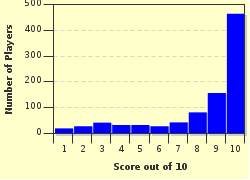Quiz Answer Key and Fun Facts
1. In the first incarnation, Lord Vishnu appears as a fish to rescue the Vedas, plants and animals. Which of the following words literally means a fish?
2. In the second incarnation, Lord Vishnu takes the form of a tortoise to help the gods churn the sea for nectar and retain their immortality. What is this incarnation known as?
3. In the third incarnation, Lord Vishnu takes the form of a boar to save the earth from a terrible demon. Which of these words correctly describes that incarnation?
4. In the next incarnation, Lord Vishnu appears in the form of a half-man and half-lion to kill evil demons who seek to outwit death and save his devotees in danger. Which of these words literally means a "man-lion"?
5. The fifth incarnation of Lord Vishnu is the first one in which he appears in a complete human form. He takes the form of a dwarf and overpowers the king Bali. What is this incarnation known as?
6. The next incarnation of Lord Vishnu is as Parashurama, the warrior-saint. References to Parashurama can be found in the Ramayana and the Mahabharata too, but what does "Parashurama" literally mean?
7. Lord Vishnu takes the incarnation of Rama in his seventh incarnation. Which of the following epics is the story of Lord Rama?
8. The eighth incarnation of Lord Vishnu is considered to be as Krishna, who has many popular stories about him and is worshipped in many forms. It is said he imparted wisdom and knowledge to the warrior Arjuna in the Mahabharata before the Great Kurukshetra War. This is today revered as a sacred scripture of Hinduism and is considered one of the most important religious classics of the world. Literally meaning the "Lord's song", what is this known as?
9. The ninth incarnation of Lord Vishnu, according to many Hindu scriptures, is as Lord Buddha, the founder of Buddhism. Lord Buddha was born as a prince under which of the following names?
10. The tenth and final incarnation of Lord Vishnu has not yet appeared, according to Hindu scriptures. It is said he will appear at the end of the current age of darkness, rid the world of the oppression of its unrighteous rulers and reestablish righteousness upon earth. What is this incarnation of Lord Vishnu known as?
Source: Author
srini701
This quiz was reviewed by FunTrivia editor
CellarDoor before going online.
Any errors found in FunTrivia content are routinely corrected through our feedback system.

